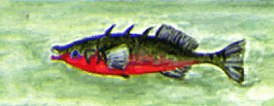Overview
 Order: Gasterosteiformes
Order: Gasterosteiformes
Family: Gasterosteidae
Species: Gasterosteus aculeatus
IUCN Status: Least Concern
Distribution: there are eight species of stickleback throughout the Northern Hemisphere. The three- spined and ten-spined may be found in Britain.
Habitat: streams, ponds, ditches, rock pools & estuaries.
Description: small, fairly deep body. Three spines in front of the dorsal fin. Colour is normally mottled, brownish-green, paler on the underside. A breeding male has a bright red belly and blue eyes.
Size: length is about 6cm.
Life-span: about three years.
Food: mainly small water invertebrates; also fish eggs and young fish.
The three-spined stickleback is one of the most familiar fish of Britain's freshwater streams and ponds. It may even be found in salty rock pools and sometimes just under the surface of the open sea. Those in salty water are much more silvery in colour than those living in freshwater. The breeding behaviour of sticklebacks is unusual in that the male looks after the eggs and young, for at least a while, whereas most other fish show no parental care at all once the eggs have been laid.
Feeding
Outside the breeding season, sticklebacks may be found in loose shoals. They are nocturnal predators, but need quite a lot of light to be able to detect the movement of their prey. They probably hunt more successfully on a moonlit night. They eat all sorts of invertebrates, such as worms, insect larvae, small snails, crustaceans and water fleas. They even eat young fish and fish eggs - sometimes searching out those of other sticklebacks!
When a victim is spotted it is chased if necessary, and the jaws are pushed open and forward very quickly so that the food is sucked in. It is then grabbed by the stickleback's tiny, sharp teeth.
The stickleback itself may be preyed on by larger predators, such as larger fish, kingfishers, herons, water shrews and otters. The spines probably protect it from some of its enemies. When the spines are raised a larger fish may find the stickleback difficult to swallow.
Breeding
Sticklebacks normally breed between late March and early August. During these months there is plenty of food around for the young fish. In the early spring, the male stickleback undergoes quite a dramatic transformation. His throat and belly become a bright orange-red, his eyes turn bright blue and silvery scales appear on his back. These colours act as a warning to other males to keep away from his territory, and they also attract females.
Attired in his bright colours, the male then sets about building a mound-shaped nest in a hollow on the bottom, using bits of water plants, bound by sticky threads ejected from his kidneys. He uses his mouth to glue the bits of plants together. When the nest is finished, the male tries to entice as many females as he can into his nest. Each female lays her eggs in the nest and the male fertilises them. He then guards the eggs, fighting off possible predators, until they hatch, which may take anything from one week to a month. The eggs need plenty of oxygen to develop, so the male directs waves of oxygen-filled water over them with his fins. About 100 young leave the nest and their father continues to look after them for another week or more until they leave to lead an independent life. They feed on water fleas and tiny worms and take about a year to develop into adults.
Sticklebacks and humans
In some areas, sticklebacks occur in great numbers and they have been turned into oil, animal feed and agricultural fertiliser. The three-spined stickleback is thought of as a pest in the Black Sea region of southeastern Europe because it eats the young of fish which are caught for human consumption and it also competes with these fish for food.
In Britain, the stickleback is not regarded as a pest and, although not seriously threatened, it has been affected by pollution of its habitats and also drainage of ponds and ditches.
Credits
Image: Stickleback (Three-spined) by Jack Wolf
 Order: Gasterosteiformes
Order: Gasterosteiformes
